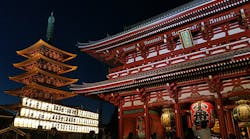TOKYO — In a rare bright spot for the country, factory output in Japan expanded again in October, according to data released this week, boosted by production of memory chips and electronic devices.
Economists were generally upbeat on the 1.4% expansion in activity — the second consecutive monthly rise — and said it signaled that Japan’s second recession in as many years would likely be short.
Retail sales data were also stronger than expected, offering a glimmer of hope after Tokyo published a string of mostly weak data on Friday — the first major figures since news that the world’s No. 3 economy had slipped back into recession.
A key inflation gauge showed prices fell in October from a year ago, while spending by households also dropped in a double blow for Prime Minister Shinzo Abe’s high-profile growth blitz, dubbed Abenomics.
The weak figures came despite signs of a tight labor market, with the headline unemployment rate at a two-decade low of 3.1%. However, the relatively upbeat factory output data published missed market expectations for a 1.8% rise and Japan’s industry ministry was cautious about the pickup.
A survey released with the figures cautioned that output would likely rise just 0.2% in November and then contract 0.9% in December. Factory output, the ministry said, is making “one step forward and one step back.”
The pickup was largely driven by demand for semiconductor chips and other electronic devices that Japan ships abroad, analysts said, while manufacturers work down their inventory levels.
Demand for Japanese-made IT and electronic parts tends to pick up in the second half of the year, SMBC Nikko economist Junichi Makino said, adding that “industrial production as a whole is gradually bottoming out.”
Earlier this month, official figures showed that Japan’s gross domestic product (GDP) shrank 0.2% in the July-September period, or an annualized contraction of 0.8%, marking the second straight quarterly decline.
Tokyo is compiling an extra budget to counter the downturn while the Bank of Japan is expected to unleash further monetary easing over the coming months.
The economy dipped into a brief recession last year after consumers tightened their belts following an increase in Japan’s consumption tax, which dealt a blow to signs that Abe’s bid to spur the once-stellar economy was working.
That downturn spurred the BoJ to sharply increase its already massive bond-buying program — a cornerstone of Abenomics — effectively printing money to boost lending.
Copyright Agence France-Presse, 2015



